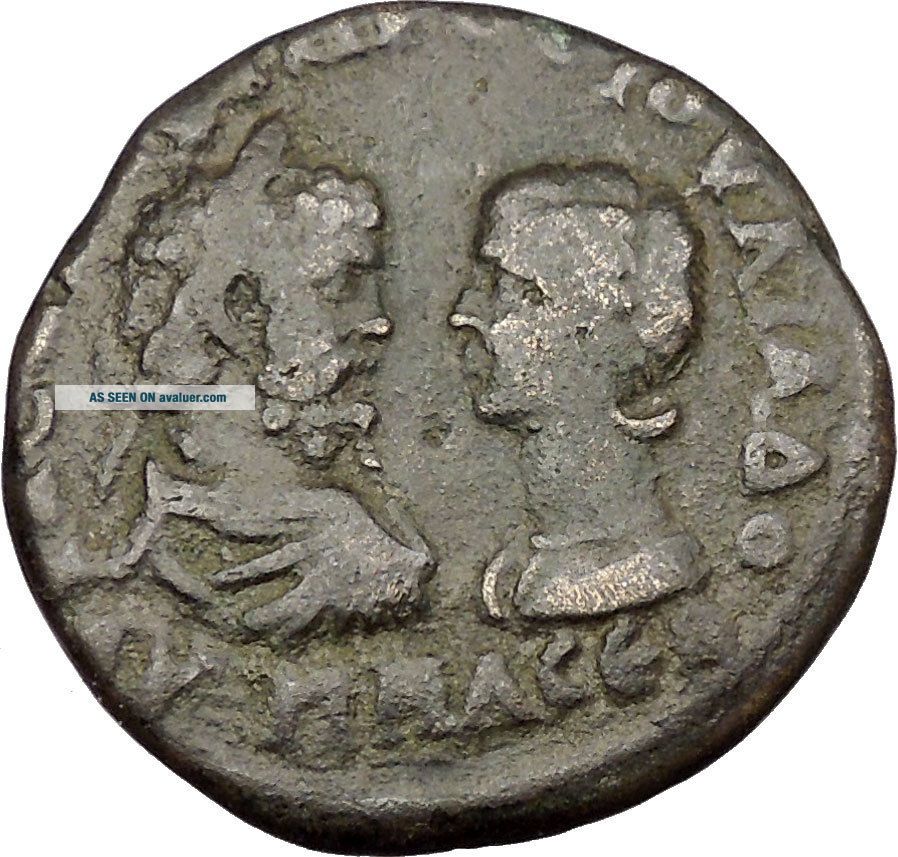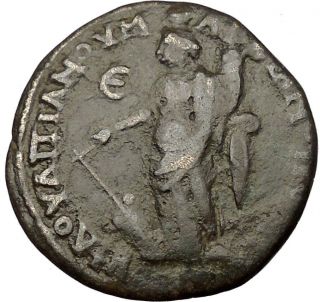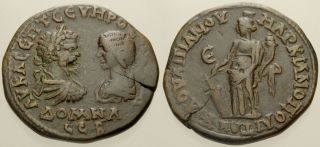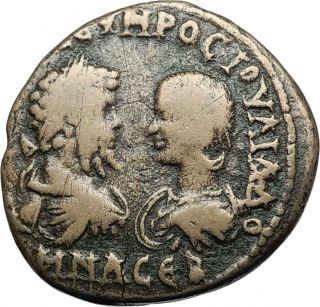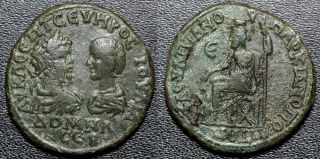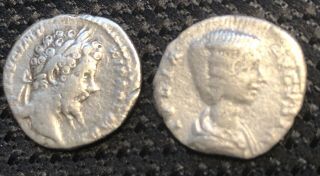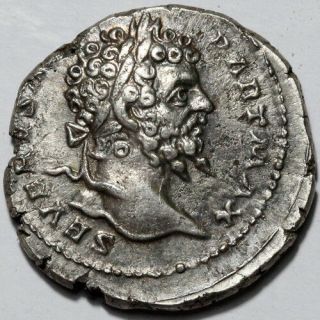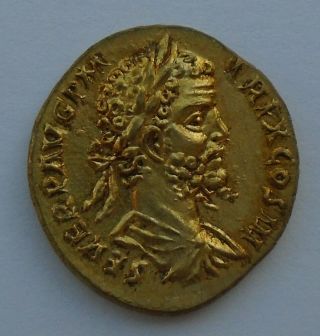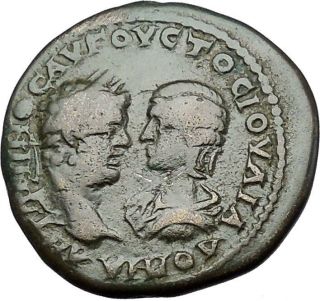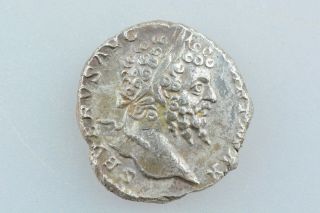Septimius Severus & Julia Domna 2Portrait Marcianopolis Tyche Roman Coin I38076
Item History & Price
| Reference Number: Avaluer:9932260 |
Item: i38076
Authentic Ancient Coin of: Septimius Severus - Roman Emperor: 193-211 A.D. -
Septimius Severus and his wifeJulia Domna, Roman Empress
Bronze 26mm (11.33 grams)Marcianopolis mint under legate Flavius Ulpianus
AV K Λ CЄΠ CЄVHPOC IOVΛIA ΔOMHA CЄB, laureate draped bust of Septimius Severus on le...ft facing right toward draped bust of Julia Domna facing left on right.
ΥΦΛ OVΛΠIANOV MAPKIANOΠOΛIT, Tychestanding left, holding rudder atop globe and cornucopia, Є in left field.You are bidding on the exact item pictured, provided with a Certificate of Authenticity and Lifetime Guarantee of Authenticity.The cornucopia (from Latin cornu copiae) or horn of plenty is a symbol of abundance and nourishment, commonly a large horn-shaped container overflowing with produce, flowers, nuts, other edibles, or wealth in some form. Originating inclassical antiquity, it has continued as a symbol inWestern art, and it is particularly associated with theThanksgiving holiday inNorth America. Allegorical depiction of the Roman goddess Abundantia with a cornucopia, by Rubens (ca. 1630) In MythologyMythology offers multipleexplanations of the origin of the cornucopia. One of the best-known involves the birth and nurturance of the infantZeus, who had to be hidden from his devouring fatherCronus. In a cave onMount Ida on the island ofCrete, baby Zeus was cared for and protected by a number of divine attendants, including the goatAmalthea ("Nourishing Goddess"), who fed him with her milk. The suckling future king of the gods had unusual abilities and strength, and in playing with his nursemaid accidentally broke off one of herhorns, which then had the divine power to provide unending nourishment, as the foster mother had to the god.In another myth, the cornucopia was created whenHeracles (RomanHercules) wrestled with the river godAchelous and wrenched off one of his horns; river gods were sometimes depicted as horned. This version is represented in theAchelous and Herculesmural painting by theAmerican Regionalist artistThomas Hart Benton.The cornucopia became the attribute of severalGreek andRoman deities, particularly those associated with the harvest, prosperity, or spiritual abundance, such as personifications of Earth (Gaia orTerra); the childPlutus, god of riches and son of the grain goddess Demeter; thenymphMaia; andFortuna, the goddess of luck, who had the power to grant prosperity. InRoman Imperial cult, abstract Roman deities who fostered peace (pax Romana) and prosperity were also depicted with a cornucopia, including Abundantia, "Abundance" personified, andAnnona, goddess of thegrain supply to the city of Rome.Pluto, the classical ruler of the underworld in themystery religions, was a giver of agricultural, mineral and spiritual wealth, and in art often holds a cornucopia to distinguish him from the gloomier Hades, who holds adrinking horn instead.Modern depictionsIn modern depictions, the cornucopia is typically a hollow, horn-shaped wicker basket filled with various kinds of festivefruit andvegetables. In North America, the cornucopia has come to be associated withThanksgiving and the harvest. Cornucopia is also the name of the annual November Wine and Food celebration inWhistler, British Columbia, Canada. Two cornucopias are seen in theflag andstate seal ofIdaho. The GreatSeal ofNorth Carolina depicts Liberty standing and Plenty holding a cornucopia. The coat of arms ofColombia, Panama, Peru andVenezuela, and the Coat of Arms of the State ofVictoria, Australia, also feature the cornucopia, symbolising prosperity.The horn of plenty is used on body art and at Halloween, as it is a symbol of fertility, fortune and abundance. Base of a statue of
Louis XV of France Tyche (Greek for luck; the Roman equivalent wasFortuna) was the presidingtutelary deity that governed the fortune and prosperity of a city, its destiny. Increasingly during the Hellenistic period, cities had their own specific iconic version of Tyche, wearing a mural crown (a crown like the walls of the city).
The Greek historian Polybius believed that when no cause can be discovered to events such as floods, droughts, frosts or even in politics, then the cause of these events may be fairly attributed to Tyche.Stylianos Spyridakis concisely expressed Tyche's appeal in a Hellenistic world of arbitrary violence and unmeaning reverses: "In the turbulent years of theEpigoni of Alexander, an awareness of the instability of human affairs led people to believe that Tyche, the blind mistress of Fortune, governed mankind with an inconstancy which explained the vicissitudes of the time."In literature, she might be given various genealogies, as a daughter ofHermes andAphrodite, or considered as one of theOceanids, daughters ofOceanus andTethys, or ofZeus. She was connected withNemesis andAgathos Daimon ("good spirit").She was uniquely venerated atItanos in Crete, as Tyche Protogeneia, linked with the AthenianProtogeneia ("firstborn"), daughter ofErechtheus, whose self-sacrifice saved the city.She had temples atCaesarea Maritima, Antioch, Alexandria andConstantinople. InAlexandria the Tychaeon, the temple of Tyche, was described byLibanius as one of the most magnificent of the entire Hellenistic world.Tyche appears on manycoins of the Hellenistic period in the three centuries before the Christian era, especially from cities in the Aegean. Unpredictable turns of fortune drive the complicated plotlines ofHellenistic romances, such as Leucippe and Clitophon or Daphnis and Chloe. She experienced a resurgence in another era of uneasy change, the final days of publicly sanctionedPaganism, between the late-fourth-century emperorsJulian andTheodosius I who definitively closed the temples. The effectiveness of her capricious power even achieved respectability in philosophical circles during that generation, though among poets it was a commonplace to revile her for a fickle harlot.In medieval art, she was depicted as carrying acornucopia, anemblematic ship's rudder, and thewheel of fortune, or she may stand on the wheel, presiding over the entire circle of fate.The constellation ofVirgo is sometimes identified as the heavenly figure of Tyche, as well as other goddesses such asDemeter andAstraea.Marcianopolis, or Marcianople was an ancient Roman city inThracia. It was located at the site of modern dayDevnya, Bulgaria.The city was so renamed by EmperorTrajan after his sisterUlpia Marciana, and was previously known as Parthenopolis. Romans repulsed aGothic attack to this town in 267 (or268), during the reign of Gallienus.Diocletian made it the capital of theMoesia Secunda province.Valens made it his winter quarters in 368 and succeeding years, EmperorJustinian I restored and fortified it. In 587, it was sacked by the king of theAvars but at once retaken by the Romans. The Roman army quartered there in 596 before crossing the Danube to assault the Avars.Between 893 and 972 it was one of the most important medieval cities in south-eastern Europe.Julia Domna (unknown date–217) was a member of theSeveran dynasty of theRoman Empire. Empress and wife ofRoman Emperor LuciusSeptimius Severus and mother of EmperorsGeta and Caracalla, Julia was among the most important women ever to exercise power behind the throne in the Roman Empire.// Family backgroundJulia was of Syrian origin from the ancient city ofEmesa. Her ancestors were Kings Priest of the famous temple ofBaal. The family lost its kingdom to Rome but continued domination of the temple of Baal. The family had an enormous wealth and was promoted to Roman senatorial aristocracy. She was the youngest daughter of high-priest GaiusJulius Bassianus and her eldest sister wasJulia Maesa. ReignIn the late 180s, Julia married future EmperorSeptimius Severus who himself was in part ofPunic background. The marriage proved to be a happy one and Severus cherished his wife and her political opinions, since she was very well read and keen on philosophy. Together, they had two sons, Lucius Septimius Bassianus (Caracalla) in 186 andPublius Septimius Geta in 189. Civil WarWhen Severus became emperor in 193 he had a civil war waiting for him, against rivals such asPescennius Niger andClodius Albinus. Julia accompanied him in his campaigns in the East, an uncommon event in a time when women were expected to wait in Rome for their husbands. Nevertheless, she remained with the emperor and among the several proofs of affection and favour are the minting of coins with her portrait and the title mater castrorum (mother of the camp).Julia now had complete power and ruled behind the Roman Empire. Many early Romans disliked the fact of her ruling over the throne when Septimius Severus was at war. Controversy and transition of powerAs empress, Julia was often involved in intrigues and had plenty of political enemies who accused her of treason and adultery. None of these accusations were proven, Severus continued to favour his wife and insisted on her company in the campaign against theBritons that started in 208. When Severus died, in 211 inYork, Julia became the mediator between their two sons.Caracalla andGeta who were to rule as joint emperors, according to their father's wishes expressed on his will. But the two young men were never fond of each other and quarrelled frequently. Geta was murdered by Caracalla's soldiers in the same year.Caracalla was now sole emperor, but his relations with his mother were difficult, as attested by several sources, probably due to his involvement in Geta's murder. Nevertheless, Julia accompanied Caracalla in his campaign against theParthian empire in 217. During this trip, Caracalla was assassinated and succeeded (briefly) byMacrinus. On hearing about the rebellion, Julia chose to commit suicide. Her body was brought to Rome and placed in the Sepulcrum C. et L. Caesaris (perhaps a separate chamber in theMausoleum of Augustus). Later, however, both her bones and those of Geta were transferred by her sisterJulia Maesa to theMausoleum of Hadrian. She was later deified.Lucius Septimius Severus (or rarely Severus I) (April 11, 145/146-February 4, 211) was aRoman general, andRoman Emperor from April 14, 193 to 211. He was born in what is now theBerber part of Rome's historicAfrica Province.Septimius Severus was born and raised atLeptis Magna (modern Berber, southeast ofCarthage, modern Tunisia). Severus came from a wealthy, distinguished family ofequestrian rank. Severus was ofItalian Roman ancestry on his mother's side and ofPunic orLibyan-Punic ancestry on his father's. Little is known of his father, Publius Septimius Geta, who held no major political status but had two cousins who served as consuls under emperorAntoninus Pius. His mother, Fulvia Pia's family moved fromItaly toNorth Africa and was of theFulvius gens, an ancient and politically influential clan, which was originally ofplebeian status. His siblings were a youngerPublius Septimius Geta and Septimia Octavilla. Severus’s maternal cousin wasPraetorian Guard and consulGaius Fulvius Plautianus.In 172, Severus was made aSenator by the then emperorMarcus Aurelius. In 187 he married secondlyJulia Domna. In 190 Severus becameconsul, and in the following year received from the emperorCommodus (successor to Marcus Aurelius) the command of thelegions in Pannonia.On the murder ofPertinax by the troops in 193, they proclaimed Severus Emperor atCarnuntum, whereupon he hurried to Italy. The former emperor, Didius Julianus, was condemned to death by the Senate and killed, and Severus took possession of Rome without opposition.The legions ofSyria, however, had proclaimedPescennius Niger emperor. At the same time, Severus felt it was reasonable to offerClodius Albinus, the powerful governor of Britannia who had probably supported Didius against him, the rank of Caesar, which implied some claim to succession. With his rearguard safe, he moved to the East and crushed Niger's forces at theBattle of Issus. The following year was devoted to suppressing Mesopotamia and other Parthian vassals who had backed Niger. When afterwards Severus declared openly his sonCaracalla as successor, Albinus was hailed emperor by his troops and moved to Gallia. Severus, after a short stay in Rome, moved northwards to meet him. OnFebruary 19, 197, in theBattle of Lugdunum, with an army of 100, 000 men, mostly composed ofIllyrian, Moesian andDacian legions, Severus defeated and killed Clodius Albinus, securing his full control over the Empire.Emperor Severus was at heart asoldier, and sought glory through military exploits. In 197 he waged a brief and successful war against theParthian Empire in retaliation for the support given to Pescennius Niger. The Parthian capitalCtesiphon was sacked by the legions, and the northern half ofMesopotamia was restored to Rome.His relations with theRoman Senate were never good. He was unpopular with them from the outset, having seized power with the help of the military, and he returned the sentiment. Severus ordered the execution of dozens of Senators on charges of corruption andconspiracy against him, replacing them with his own favorites.He also disbanded thePraetorian Guard and replaced it with one of his own, made up of 50, 000 loyal soldiers mainly camped atAlbanum, near Rome (also probably to grant the emperor a kind of centralized reserve). During his reign the number of legions was also increased from 25/30 to 33. He also increased the number of auxiliary corps (numerii), many of these troops coming from the Eastern borders. Additionally the annual wage for a soldier was raised from 300 to 500 denarii.Although his actions turned Rome into a militarydictatorship, he was popular with the citizens of Rome, having stamped out the rampant corruption of Commodus's reign. When he returned from his victory over the Parthians, he erected theArch of Septimius Severus in Rome.According to Cassius Dio, however, after 197 Severus fell heavily under the influence of his Praetorian Prefect, Gaius Fulvius Plautianus, who came to have almost total control of most branches of the imperial administration. Plautianus's daughter, Fulvia Plautilla, was married to Severus's son, Caracalla. Plautianus’s excessive power came to an end in 205, when he was denounced by the Emperor's dying brother and killed. The two following praefecti, including the juristAemilius Papinianus, received however even larger powers.Campaigns in Caledonia (Scotland) Starting from 208 Severus undertook a number of military actions inRoman Britain, reconstructingHadrian's Wall and campaigning inScotland.He reached the area of theMoray Firth in his last campaign in Caledonia, as was called Scotland by the Romans.. In 210 obtained a peace with thePicts that lasted practically until the final withdrawal of the Roman legions from Britain, before falling severely ill inEboracum (York).DeathHe is famously said to have given the advice to his sons: "Be harmonious, enrich the soldiers, and scorn all other men" before he died at Eboracum onFebruary 4, 211. Upon his death in 211, Severus wasdeified by the Senate and succeeded by his sons, Caracalla andGeta, who were advised by his wifeJulia Domna. The stability Severus provided the Empire was soon gone under their reign.Accomplishments and RecordThough his military expenditure was costly to the empire, Severus was the strong, able ruler that Rome needed at the time. He began a tradition of effective emperors elevated solely by the military. His policy of an expanded and better-rewarded army was criticized by his contemporaryDio Cassius andHerodianus: in particular, they pointed out the increasing burden (in the form of taxes and services) the civilian population had to bear to maintain the new army.Severus was also distinguished for his buildings. Apart from the triumphal arch in the Roman Forum carrying his full name, he also built theSeptizodium in Rome and enriched greatly his native city ofLeptis Magna (including another triumphal arch on the occasion of his visit of 203).Severus and Christianity Christians werepersecuted during the reign of Septimus Severus. Severus allowed the enforcement of policies already long-established, which meant that Roman authorities did not intentionally seek out Christians, but when people were accused of being Christians they could either curseJesus and make an offering toRoman gods, or be executed. Furthermore, wishing to strengthen the peace by encouraging religious harmony throughsyncretism, Severus tried to limit the spread of the two quarrelsome groups who refused to yield to syncretism by outlawingconversion to Christianity orJudaism. Individual officials availed themselves of the laws to proceed with rigor against the Christians. Naturally the emperor, with his strict conception of law, did not hinder such partial persecution, which took place inEgypt and theThebaid, as well as inAfrica proconsularis and the East. Christianmartyrs were numerous in Alexandria (cf.Clement of Alexandria, Stromata, ii. 20;Eusebius, Church History, V., xxvi., VI., i.). No less severe were the persecutions in Africa, which seem to have begun in 197 or 198 (cf.Tertullian's Ad martyres), and included the Christians known in theRoman martyrology as the martyrs ofMadaura. Probably in 202 or 203Felicitas andPerpetua suffered for their faith. Persecution again raged for a short time under the proconsulScapula in 211, especially inNumidia andMauritania. Later accounts of a Gallic persecution, especially atLyon, are legendary. In general it may thus be said that the position of the Christians under Septimius Severus was the same as under theAntonines; but the law of this Emperor at least shows clearly that therescript ofTrajan[ neededclarification] had failed to execute its purpose. Frequently Asked Questions How long until my order is shipped?
Depending on the volume of sales, it may take up to 5 business days forshipment of your order after the receipt of payment. How will I know when the order was shipped?
After your order has shipped, you will be left positive feedback, and thatdate should be used as a basis of estimating an arrival date. After you shipped the order, how long will the mail take?
USPS First Class mail takes about 3-5 business days to arrive in the U.S., international shipping times cannot be estimated as they vary from countryto country. I am not responsible for any USPS delivery delays, especiallyfor an international package. What is a certificate of authenticity and what guarantees do you givethat the item is authentic?
Each of the items sold here, is provided with a Certificate of Authenticity, and a Lifetime Guarantee of Authenticity, issued by a world-renowned numismatic and antique expert that has identified over 10000 ancient coins and has provided themwith the same guarantee. You will be quite happy with what you get with the COA; a professional presentation of the coin, with all of the relevantinformation and a picture of the coin you saw in the listing. Compared to other certification companies, the certificate of authenticity is a $25-50 value. So buy a coin today and own a piece of history, guaranteed. Is there a money back guarantee?
I offer a 30 day unconditional money back guarantee. I stand behind my coins and would be willing to exchange your order for either store credit towards other coins, or refund, minus shipping expenses, within 30 days from the receipt of your order. My goal is to have the returning customers for a lifetime, and I am so sure in my coins, their authenticity, numismatic value and beauty, I can offer such a guarantee. Is there a number I can call you with questions about my order? You can contact me directly via ask seller a question and request my telephone number, or go to my About Me Page to get my contact information only in regards to items purchased on eBay. When should I leave feedback?
Once you receive your order, please leave a positive. Please don't leave anynegative feedbacks, as it happens many times that people rush to leavefeedback before letting sufficient time for the order to arrive. Also, ifyou sent an email, make sure to check for my reply in your messages beforeclaiming that you didn't receive a response. The matter of fact is that anyissues can be resolved, as reputation is most important to me. My goal is toprovide superior products and quality of service.
00143
Authentic Ancient Coin of: Septimius Severus - Roman Emperor: 193-211 A.D. -
Septimius Severus and his wifeJulia Domna, Roman Empress
Bronze 26mm (11.33 grams)Marcianopolis mint under legate Flavius Ulpianus
AV K Λ CЄΠ CЄVHPOC IOVΛIA ΔOMHA CЄB, laureate draped bust of Septimius Severus on le...ft facing right toward draped bust of Julia Domna facing left on right.
ΥΦΛ OVΛΠIANOV MAPKIANOΠOΛIT, Tychestanding left, holding rudder atop globe and cornucopia, Є in left field.You are bidding on the exact item pictured, provided with a Certificate of Authenticity and Lifetime Guarantee of Authenticity.The cornucopia (from Latin cornu copiae) or horn of plenty is a symbol of abundance and nourishment, commonly a large horn-shaped container overflowing with produce, flowers, nuts, other edibles, or wealth in some form. Originating inclassical antiquity, it has continued as a symbol inWestern art, and it is particularly associated with theThanksgiving holiday inNorth America. Allegorical depiction of the Roman goddess Abundantia with a cornucopia, by Rubens (ca. 1630) In MythologyMythology offers multipleexplanations of the origin of the cornucopia. One of the best-known involves the birth and nurturance of the infantZeus, who had to be hidden from his devouring fatherCronus. In a cave onMount Ida on the island ofCrete, baby Zeus was cared for and protected by a number of divine attendants, including the goatAmalthea ("Nourishing Goddess"), who fed him with her milk. The suckling future king of the gods had unusual abilities and strength, and in playing with his nursemaid accidentally broke off one of herhorns, which then had the divine power to provide unending nourishment, as the foster mother had to the god.In another myth, the cornucopia was created whenHeracles (RomanHercules) wrestled with the river godAchelous and wrenched off one of his horns; river gods were sometimes depicted as horned. This version is represented in theAchelous and Herculesmural painting by theAmerican Regionalist artistThomas Hart Benton.The cornucopia became the attribute of severalGreek andRoman deities, particularly those associated with the harvest, prosperity, or spiritual abundance, such as personifications of Earth (Gaia orTerra); the childPlutus, god of riches and son of the grain goddess Demeter; thenymphMaia; andFortuna, the goddess of luck, who had the power to grant prosperity. InRoman Imperial cult, abstract Roman deities who fostered peace (pax Romana) and prosperity were also depicted with a cornucopia, including Abundantia, "Abundance" personified, andAnnona, goddess of thegrain supply to the city of Rome.Pluto, the classical ruler of the underworld in themystery religions, was a giver of agricultural, mineral and spiritual wealth, and in art often holds a cornucopia to distinguish him from the gloomier Hades, who holds adrinking horn instead.Modern depictionsIn modern depictions, the cornucopia is typically a hollow, horn-shaped wicker basket filled with various kinds of festivefruit andvegetables. In North America, the cornucopia has come to be associated withThanksgiving and the harvest. Cornucopia is also the name of the annual November Wine and Food celebration inWhistler, British Columbia, Canada. Two cornucopias are seen in theflag andstate seal ofIdaho. The GreatSeal ofNorth Carolina depicts Liberty standing and Plenty holding a cornucopia. The coat of arms ofColombia, Panama, Peru andVenezuela, and the Coat of Arms of the State ofVictoria, Australia, also feature the cornucopia, symbolising prosperity.The horn of plenty is used on body art and at Halloween, as it is a symbol of fertility, fortune and abundance. Base of a statue of
Louis XV of France Tyche (Greek for luck; the Roman equivalent wasFortuna) was the presidingtutelary deity that governed the fortune and prosperity of a city, its destiny. Increasingly during the Hellenistic period, cities had their own specific iconic version of Tyche, wearing a mural crown (a crown like the walls of the city).
The Greek historian Polybius believed that when no cause can be discovered to events such as floods, droughts, frosts or even in politics, then the cause of these events may be fairly attributed to Tyche.Stylianos Spyridakis concisely expressed Tyche's appeal in a Hellenistic world of arbitrary violence and unmeaning reverses: "In the turbulent years of theEpigoni of Alexander, an awareness of the instability of human affairs led people to believe that Tyche, the blind mistress of Fortune, governed mankind with an inconstancy which explained the vicissitudes of the time."In literature, she might be given various genealogies, as a daughter ofHermes andAphrodite, or considered as one of theOceanids, daughters ofOceanus andTethys, or ofZeus. She was connected withNemesis andAgathos Daimon ("good spirit").She was uniquely venerated atItanos in Crete, as Tyche Protogeneia, linked with the AthenianProtogeneia ("firstborn"), daughter ofErechtheus, whose self-sacrifice saved the city.She had temples atCaesarea Maritima, Antioch, Alexandria andConstantinople. InAlexandria the Tychaeon, the temple of Tyche, was described byLibanius as one of the most magnificent of the entire Hellenistic world.Tyche appears on manycoins of the Hellenistic period in the three centuries before the Christian era, especially from cities in the Aegean. Unpredictable turns of fortune drive the complicated plotlines ofHellenistic romances, such as Leucippe and Clitophon or Daphnis and Chloe. She experienced a resurgence in another era of uneasy change, the final days of publicly sanctionedPaganism, between the late-fourth-century emperorsJulian andTheodosius I who definitively closed the temples. The effectiveness of her capricious power even achieved respectability in philosophical circles during that generation, though among poets it was a commonplace to revile her for a fickle harlot.In medieval art, she was depicted as carrying acornucopia, anemblematic ship's rudder, and thewheel of fortune, or she may stand on the wheel, presiding over the entire circle of fate.The constellation ofVirgo is sometimes identified as the heavenly figure of Tyche, as well as other goddesses such asDemeter andAstraea.Marcianopolis, or Marcianople was an ancient Roman city inThracia. It was located at the site of modern dayDevnya, Bulgaria.The city was so renamed by EmperorTrajan after his sisterUlpia Marciana, and was previously known as Parthenopolis. Romans repulsed aGothic attack to this town in 267 (or268), during the reign of Gallienus.Diocletian made it the capital of theMoesia Secunda province.Valens made it his winter quarters in 368 and succeeding years, EmperorJustinian I restored and fortified it. In 587, it was sacked by the king of theAvars but at once retaken by the Romans. The Roman army quartered there in 596 before crossing the Danube to assault the Avars.Between 893 and 972 it was one of the most important medieval cities in south-eastern Europe.Julia Domna (unknown date–217) was a member of theSeveran dynasty of theRoman Empire. Empress and wife ofRoman Emperor LuciusSeptimius Severus and mother of EmperorsGeta and Caracalla, Julia was among the most important women ever to exercise power behind the throne in the Roman Empire.// Family backgroundJulia was of Syrian origin from the ancient city ofEmesa. Her ancestors were Kings Priest of the famous temple ofBaal. The family lost its kingdom to Rome but continued domination of the temple of Baal. The family had an enormous wealth and was promoted to Roman senatorial aristocracy. She was the youngest daughter of high-priest GaiusJulius Bassianus and her eldest sister wasJulia Maesa. ReignIn the late 180s, Julia married future EmperorSeptimius Severus who himself was in part ofPunic background. The marriage proved to be a happy one and Severus cherished his wife and her political opinions, since she was very well read and keen on philosophy. Together, they had two sons, Lucius Septimius Bassianus (Caracalla) in 186 andPublius Septimius Geta in 189. Civil WarWhen Severus became emperor in 193 he had a civil war waiting for him, against rivals such asPescennius Niger andClodius Albinus. Julia accompanied him in his campaigns in the East, an uncommon event in a time when women were expected to wait in Rome for their husbands. Nevertheless, she remained with the emperor and among the several proofs of affection and favour are the minting of coins with her portrait and the title mater castrorum (mother of the camp).Julia now had complete power and ruled behind the Roman Empire. Many early Romans disliked the fact of her ruling over the throne when Septimius Severus was at war. Controversy and transition of powerAs empress, Julia was often involved in intrigues and had plenty of political enemies who accused her of treason and adultery. None of these accusations were proven, Severus continued to favour his wife and insisted on her company in the campaign against theBritons that started in 208. When Severus died, in 211 inYork, Julia became the mediator between their two sons.Caracalla andGeta who were to rule as joint emperors, according to their father's wishes expressed on his will. But the two young men were never fond of each other and quarrelled frequently. Geta was murdered by Caracalla's soldiers in the same year.Caracalla was now sole emperor, but his relations with his mother were difficult, as attested by several sources, probably due to his involvement in Geta's murder. Nevertheless, Julia accompanied Caracalla in his campaign against theParthian empire in 217. During this trip, Caracalla was assassinated and succeeded (briefly) byMacrinus. On hearing about the rebellion, Julia chose to commit suicide. Her body was brought to Rome and placed in the Sepulcrum C. et L. Caesaris (perhaps a separate chamber in theMausoleum of Augustus). Later, however, both her bones and those of Geta were transferred by her sisterJulia Maesa to theMausoleum of Hadrian. She was later deified.Lucius Septimius Severus (or rarely Severus I) (April 11, 145/146-February 4, 211) was aRoman general, andRoman Emperor from April 14, 193 to 211. He was born in what is now theBerber part of Rome's historicAfrica Province.Septimius Severus was born and raised atLeptis Magna (modern Berber, southeast ofCarthage, modern Tunisia). Severus came from a wealthy, distinguished family ofequestrian rank. Severus was ofItalian Roman ancestry on his mother's side and ofPunic orLibyan-Punic ancestry on his father's. Little is known of his father, Publius Septimius Geta, who held no major political status but had two cousins who served as consuls under emperorAntoninus Pius. His mother, Fulvia Pia's family moved fromItaly toNorth Africa and was of theFulvius gens, an ancient and politically influential clan, which was originally ofplebeian status. His siblings were a youngerPublius Septimius Geta and Septimia Octavilla. Severus’s maternal cousin wasPraetorian Guard and consulGaius Fulvius Plautianus.In 172, Severus was made aSenator by the then emperorMarcus Aurelius. In 187 he married secondlyJulia Domna. In 190 Severus becameconsul, and in the following year received from the emperorCommodus (successor to Marcus Aurelius) the command of thelegions in Pannonia.On the murder ofPertinax by the troops in 193, they proclaimed Severus Emperor atCarnuntum, whereupon he hurried to Italy. The former emperor, Didius Julianus, was condemned to death by the Senate and killed, and Severus took possession of Rome without opposition.The legions ofSyria, however, had proclaimedPescennius Niger emperor. At the same time, Severus felt it was reasonable to offerClodius Albinus, the powerful governor of Britannia who had probably supported Didius against him, the rank of Caesar, which implied some claim to succession. With his rearguard safe, he moved to the East and crushed Niger's forces at theBattle of Issus. The following year was devoted to suppressing Mesopotamia and other Parthian vassals who had backed Niger. When afterwards Severus declared openly his sonCaracalla as successor, Albinus was hailed emperor by his troops and moved to Gallia. Severus, after a short stay in Rome, moved northwards to meet him. OnFebruary 19, 197, in theBattle of Lugdunum, with an army of 100, 000 men, mostly composed ofIllyrian, Moesian andDacian legions, Severus defeated and killed Clodius Albinus, securing his full control over the Empire.Emperor Severus was at heart asoldier, and sought glory through military exploits. In 197 he waged a brief and successful war against theParthian Empire in retaliation for the support given to Pescennius Niger. The Parthian capitalCtesiphon was sacked by the legions, and the northern half ofMesopotamia was restored to Rome.His relations with theRoman Senate were never good. He was unpopular with them from the outset, having seized power with the help of the military, and he returned the sentiment. Severus ordered the execution of dozens of Senators on charges of corruption andconspiracy against him, replacing them with his own favorites.He also disbanded thePraetorian Guard and replaced it with one of his own, made up of 50, 000 loyal soldiers mainly camped atAlbanum, near Rome (also probably to grant the emperor a kind of centralized reserve). During his reign the number of legions was also increased from 25/30 to 33. He also increased the number of auxiliary corps (numerii), many of these troops coming from the Eastern borders. Additionally the annual wage for a soldier was raised from 300 to 500 denarii.Although his actions turned Rome into a militarydictatorship, he was popular with the citizens of Rome, having stamped out the rampant corruption of Commodus's reign. When he returned from his victory over the Parthians, he erected theArch of Septimius Severus in Rome.According to Cassius Dio, however, after 197 Severus fell heavily under the influence of his Praetorian Prefect, Gaius Fulvius Plautianus, who came to have almost total control of most branches of the imperial administration. Plautianus's daughter, Fulvia Plautilla, was married to Severus's son, Caracalla. Plautianus’s excessive power came to an end in 205, when he was denounced by the Emperor's dying brother and killed. The two following praefecti, including the juristAemilius Papinianus, received however even larger powers.Campaigns in Caledonia (Scotland) Starting from 208 Severus undertook a number of military actions inRoman Britain, reconstructingHadrian's Wall and campaigning inScotland.He reached the area of theMoray Firth in his last campaign in Caledonia, as was called Scotland by the Romans.. In 210 obtained a peace with thePicts that lasted practically until the final withdrawal of the Roman legions from Britain, before falling severely ill inEboracum (York).DeathHe is famously said to have given the advice to his sons: "Be harmonious, enrich the soldiers, and scorn all other men" before he died at Eboracum onFebruary 4, 211. Upon his death in 211, Severus wasdeified by the Senate and succeeded by his sons, Caracalla andGeta, who were advised by his wifeJulia Domna. The stability Severus provided the Empire was soon gone under their reign.Accomplishments and RecordThough his military expenditure was costly to the empire, Severus was the strong, able ruler that Rome needed at the time. He began a tradition of effective emperors elevated solely by the military. His policy of an expanded and better-rewarded army was criticized by his contemporaryDio Cassius andHerodianus: in particular, they pointed out the increasing burden (in the form of taxes and services) the civilian population had to bear to maintain the new army.Severus was also distinguished for his buildings. Apart from the triumphal arch in the Roman Forum carrying his full name, he also built theSeptizodium in Rome and enriched greatly his native city ofLeptis Magna (including another triumphal arch on the occasion of his visit of 203).Severus and Christianity Christians werepersecuted during the reign of Septimus Severus. Severus allowed the enforcement of policies already long-established, which meant that Roman authorities did not intentionally seek out Christians, but when people were accused of being Christians they could either curseJesus and make an offering toRoman gods, or be executed. Furthermore, wishing to strengthen the peace by encouraging religious harmony throughsyncretism, Severus tried to limit the spread of the two quarrelsome groups who refused to yield to syncretism by outlawingconversion to Christianity orJudaism. Individual officials availed themselves of the laws to proceed with rigor against the Christians. Naturally the emperor, with his strict conception of law, did not hinder such partial persecution, which took place inEgypt and theThebaid, as well as inAfrica proconsularis and the East. Christianmartyrs were numerous in Alexandria (cf.Clement of Alexandria, Stromata, ii. 20;Eusebius, Church History, V., xxvi., VI., i.). No less severe were the persecutions in Africa, which seem to have begun in 197 or 198 (cf.Tertullian's Ad martyres), and included the Christians known in theRoman martyrology as the martyrs ofMadaura. Probably in 202 or 203Felicitas andPerpetua suffered for their faith. Persecution again raged for a short time under the proconsulScapula in 211, especially inNumidia andMauritania. Later accounts of a Gallic persecution, especially atLyon, are legendary. In general it may thus be said that the position of the Christians under Septimius Severus was the same as under theAntonines; but the law of this Emperor at least shows clearly that therescript ofTrajan[ neededclarification] had failed to execute its purpose. Frequently Asked Questions How long until my order is shipped?
Depending on the volume of sales, it may take up to 5 business days forshipment of your order after the receipt of payment. How will I know when the order was shipped?
After your order has shipped, you will be left positive feedback, and thatdate should be used as a basis of estimating an arrival date. After you shipped the order, how long will the mail take?
USPS First Class mail takes about 3-5 business days to arrive in the U.S., international shipping times cannot be estimated as they vary from countryto country. I am not responsible for any USPS delivery delays, especiallyfor an international package. What is a certificate of authenticity and what guarantees do you givethat the item is authentic?
Each of the items sold here, is provided with a Certificate of Authenticity, and a Lifetime Guarantee of Authenticity, issued by a world-renowned numismatic and antique expert that has identified over 10000 ancient coins and has provided themwith the same guarantee. You will be quite happy with what you get with the COA; a professional presentation of the coin, with all of the relevantinformation and a picture of the coin you saw in the listing. Compared to other certification companies, the certificate of authenticity is a $25-50 value. So buy a coin today and own a piece of history, guaranteed. Is there a money back guarantee?
I offer a 30 day unconditional money back guarantee. I stand behind my coins and would be willing to exchange your order for either store credit towards other coins, or refund, minus shipping expenses, within 30 days from the receipt of your order. My goal is to have the returning customers for a lifetime, and I am so sure in my coins, their authenticity, numismatic value and beauty, I can offer such a guarantee. Is there a number I can call you with questions about my order? You can contact me directly via ask seller a question and request my telephone number, or go to my About Me Page to get my contact information only in regards to items purchased on eBay. When should I leave feedback?
Once you receive your order, please leave a positive. Please don't leave anynegative feedbacks, as it happens many times that people rush to leavefeedback before letting sufficient time for the order to arrive. Also, ifyou sent an email, make sure to check for my reply in your messages beforeclaiming that you didn't receive a response. The matter of fact is that anyissues can be resolved, as reputation is most important to me. My goal is toprovide superior products and quality of service.
00143



